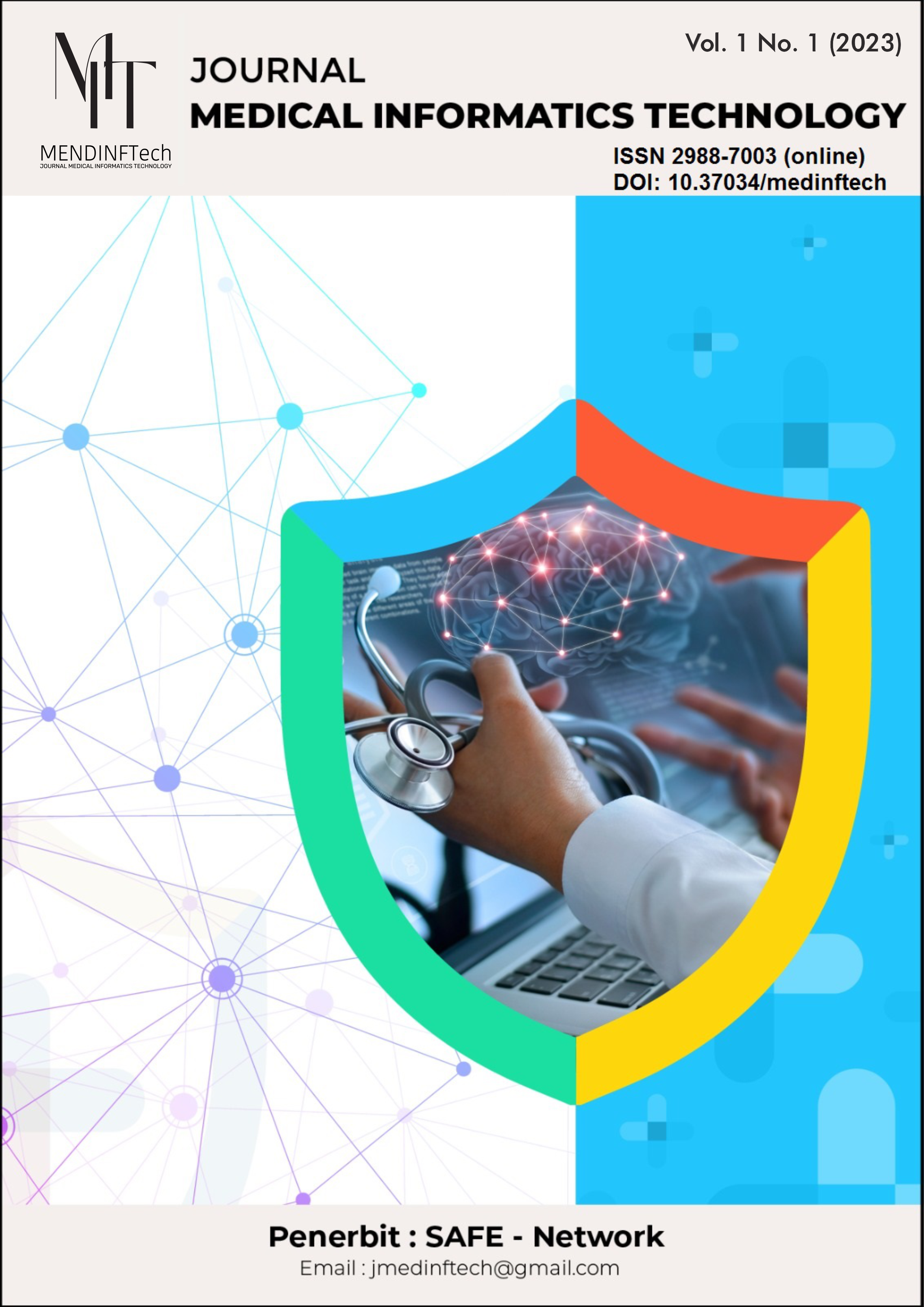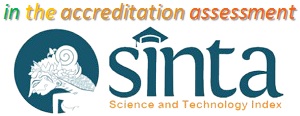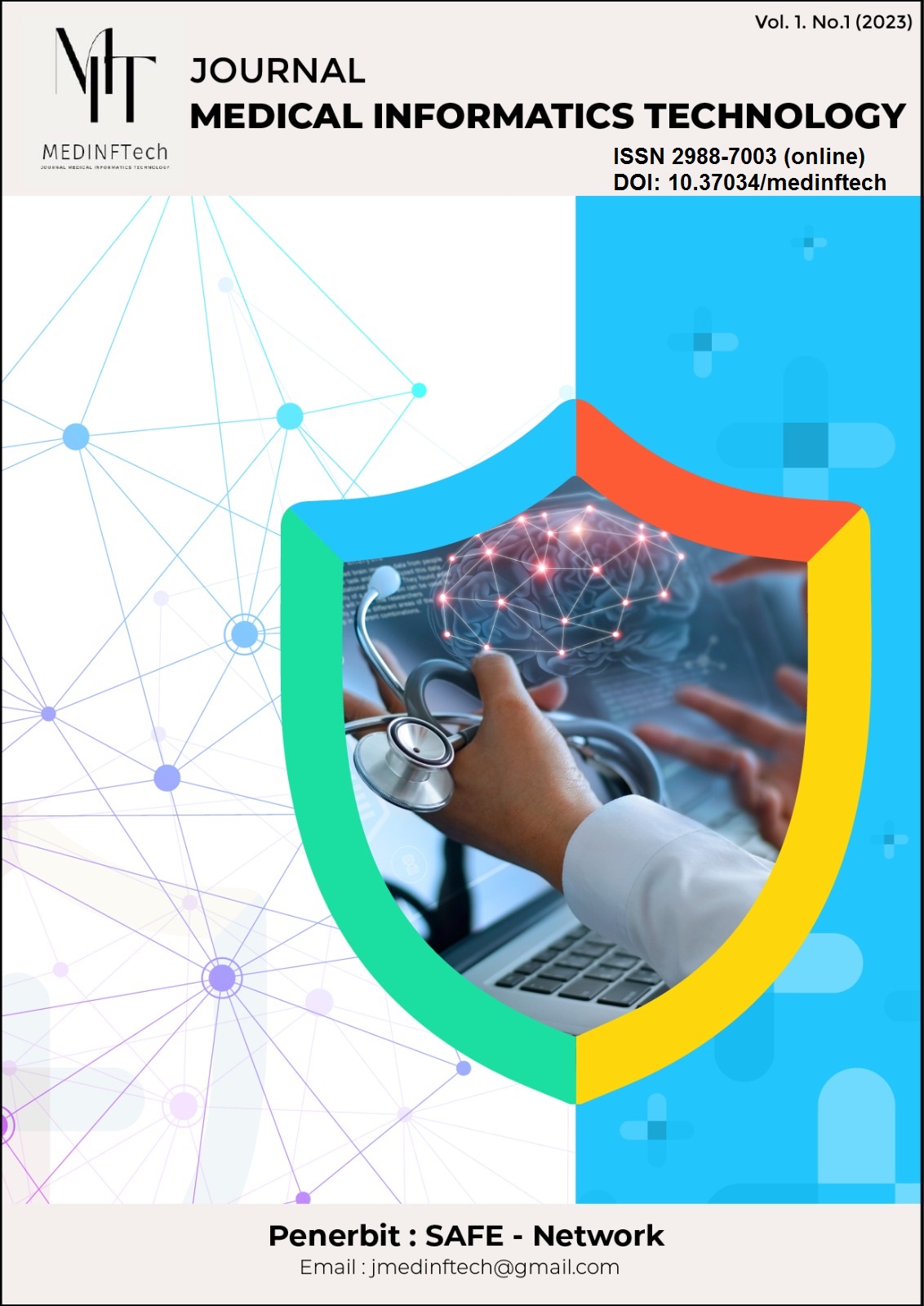Logistic Regression with Hyper Parameter Tuning Optimization for Heart Failure Prediction
DOI:
https://doi.org/10.37034/medinftech.v1i1.3Keywords:
Logistic Regression, Hyper Parameter Tuning, Heart Failure Prediction, Feature Selection, OptimizationAbstract
Heart failure is a major public health concern that causes a substantial number of deaths worldwide. Risk
factor analysis is required to diagnose and treat patients with heart failure. The logistic regression with hyper parameter tuning optimization is presented in this research, with ejection fraction, high blood pressure, age, and serum creatinine as relevant risk factors. This study indicates that better data preparation utilizing Deep Learning with hyper parameter adjustment be used to determine the best parameter that has a substantial influence as a risk factor for heart failure. The experiments employed data from the Faisalabad Institute of Cardiology and Allied Hospital in Faisalabad (Punjab, Pakistan), which included 299 samples. The experimental findings reveal that the proposed approach obtains a recall of 63.16% greater than related works.
Downloads
References
D. Chicco and G. Jurman, “Machine learning can predict survival of patients with heart failure from serum creatinine and ejection fraction alone,” BMC Med Inform Decis Mak, vol. 20, no. 1, Feb. 2020, doi: 10.1186/s12911-020-1023-5.
World Health Organization, “Cardiovascular diseases (CVDs),”https://www.who.int/news-room/factsheets/detail/cardiovascular-diseases-(cvds).
L. and B. I. National Heart, “What Is Heart Failure, 2022,”https://www.nhlbi.nih.gov/health/heart-failure.
Uci.edu, “UCI Machine Learning Repository.” https://archive.ics.uci.edu/ml/datasets/Heart+failure+clinical+records (accessed May 11, 2023).
T. Milo and A. Somech, “Automating Exploratory Data Analysis via Machine Learning: An Overview,” in Proceedings of the ACM SIGMOD International Conference on Management of Data, Association for Computing Machinery, Jun. 2020, pp. 2617–2622. doi: 10.1145/3318464.3383126.
G. Chandrashekar and F. Sahin, “32 A survey on feature selection methods,” Computers and Electrical Engineering, vol. 40, no. 1, pp. 16–28, Jan. 2014, doi: 10.1016/j.compeleceng.2013.11.024.
D. Chicco and G. Jurman, “Machine learning can predict survival of patients with heart failure from serum creatinine and ejection fraction alone,” BMC Med Inform Decis Mak, vol. 20, no. 1, Feb. 2020, doi: 10.1186/s12911-020-1023-5.
Kim YT, Kim DK, Kim H, and Kim DJ, 29 A comparison of oversampling methods for constructing a prognostic model in the patient with heart failure. 2020. doi: https://doi.org/10.1109/ICTC49870.2020.9289522.
M. Al Mehedi Hasan, J. Shin, U. Das, and A. Yakin Srizon, “Identifying Prognostic Features for Predicting Heart Failure by Using Machine Learning Algorithm,” in ACM International Conference Proceeding Series, Association for Computing Machinery, Mar. 2021, pp. 40–46. doi: 10.1145/3460238.3460245.
A. Newaz, N. Ahmed, and F. Shahriyar Haq, “Survival prediction of heart failure patients using machine learning techniques,”Inform Med Unlocked, vol. 26, Jan. 2021, doi: 10.1016/j.imu.2021.100772.
P. Ghosh et al., “Efficient prediction of cardiovascular disease using machine learning algorithms with relief and lasso feature selection techniques,” IEEE Access, vol. 9, pp. 19304–19326, 2021, doi: 10.1109/ACCESS.2021.3053759.
A. C. M. da Silveira, Á. Sobrinho, L. D. da Silva, E. de B. Costa, M. E. Pinheiro, and A. Perkusich, “Exploring Early Prediction of Chronic Kidney Disease Using Machine Learning Algorithms for Small and Imbalanced Datasets,” Applied Sciences (Switzerland), vol. 12, no. 7, Apr. 2022, doi: 10.3390/app12073673.
L. Munkhdalai, T. Munkhdalai, K. H. Park, H. G. Lee, M. Li, and K. H. Ryu, “Mixture of Activation Functions with Extended MinMax Normalization for Forex Market Prediction,” IEEE Access, vol. 7, pp. 183680–183691, 2019, doi:
1109/ACCESS.2019.2959789.
Vatsal Gajera, Shubham, Rishabh Gupta, and Prasanta K. Jana, An Effective Multi-Objective Task Scheduling Algorithm using MinMax Normalization in Cloud Computing.
W.J. Dixon and F.J. Massey Jr, “Introduction to statistical analysis,” 1951.
A. Ishaq et al., "Improving the Prediction of Heart Failure Patients’ Survival Using SMOTE and Effective Data Mining Techniques," in IEEE Access, vol. 9, pp. 39707-39716, 2021, doi: 10.1109/ACCESS.2021.3064084.
J. W. Tukey, “Exploratory Data Analysis,” vol. 2, pp. 131–160, 1977.
E. C. Zabor, C. A. Reddy, R. D. Tendulkar, and S. Patil, “Logistic Regression in Clinical Studies,” Int J Radiat Oncol Biol Phys, vol. 112, no. 2, pp. 271–277, Feb. 2022, doi: 10.1016/j.ijrobp.2021.08.007.
Ernawan, Ferda & Handayani, Kartika & Fakhreldin, Mohammad & Abbker, Yagoub. (2022). Light Gradient Boosting with Hyper Parameter Tuning Optimization for COVID-19 Prediction. International Journal of Advanced Computer Science and Applications. 13. 514-523. 10.14569/IJACSA.2022.0130859.
Md Mamun Ali et al., “Machine learning-based statistical analysis for early stage detection of cervical cancer,” Comput Biol Med, vol. 139, 2021.
M. M. Ali, B. K. Paul, K. Ahmed, F. M. Bui, J. M. W. Quinn, and M. A. Moni, “Heart disease prediction using supervised machine learning algorithms: Performance analysis and comparison,”Comput Biol Med, vol. 136, Sep. 2021, doi: 10.1016/j.compbiomed.2021.104672.
Asifa Afsari Hemu, Rabeya Begum Mim, Md Mamun Ali, Md. Nayer, Kawsar Ahmed, and Francis M. Bui, “Identification of Significant Risk Factors and Impact for ASD Prediction among Children Using Machine Learning Approach,” in Second International Conference on Advances in Electrical, Computing, Communication and Sustainable Technologies (ICAECT), 2022.
Md. Sazzad Hossain, Mehedi Hassan Shovo, Md. Mamun Ali, Md. Nayer, Kawsar Ahmed, and Francis M. Bui, “ML_SPS: Stroke Prediction System Employing Machine Learning Approach,” in Artificial Intelligence and Data Science, 2022, pp. 215–226.
K. Ahmed and M. Z. Rahman, “Early Prevention and Detection of Skin Cancer Risk using Data Mining,” 2013.
R. Vankdothu and M. A. Hameed, “Brain tumor MRI images identification and classification based on the recurrent convolutional neural network,” Measurement: Sensors, vol. 24, Dec. 2022, doi: 10.1016/j.measen.2022.100412.
Downloads
Published
How to Cite
Issue
Section
License
Copyright (c) 2023 Journal Medical Informatics Technology

This work is licensed under a Creative Commons Attribution-NonCommercial 4.0 International License.








